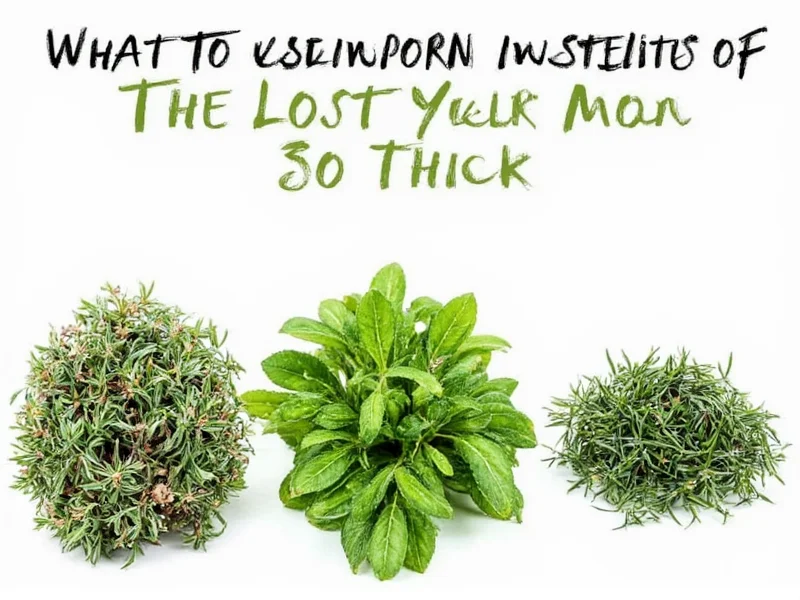The most effective thyme substitutes are oregano (use 1:1 ratio), marjoram (1:1), rosemary (use half the amount), savory (1:1), and herbes de provence (1:1). For Mediterranean dishes, oregano works best; for poultry, try marjoram; and for robust meats, use rosemary sparingly. Fresh substitutes generally require 3 times more than dried thyme in recipes.
Understanding Thyme's Unique Flavor Profile
Before exploring thyme alternatives, it's essential to understand what makes thyme distinctive in culinary applications. Thyme offers a complex flavor profile with earthy, slightly minty, and subtle lemon notes, plus a gentle warmth. This versatile herb contains thymol, the compound responsible for its distinctive aroma and antimicrobial properties. When seeking what to use instead of thyme, consider whether your recipe needs thyme's earthiness, its subtle citrus notes, or its herbal backbone.
Thyme works exceptionally well in slow-cooked dishes where its flavors can fully develop. The dried version has a more concentrated flavor than fresh thyme, with dried thyme being approximately three times stronger. This concentration factor significantly impacts substitution ratios when you need alternatives to thyme in your cooking.
Top Thyme Substitutes and Their Best Applications
Not all thyme replacements work equally well in every dish. The ideal substitute depends on your specific recipe and desired flavor outcome. Here's a detailed comparison of the most reliable thyme alternatives:
| Substitute | Substitution Ratio | Best For | Flavor Notes |
|---|---|---|---|
| Oregano | 1:1 (dried:dried) | Mediterranean dishes, tomato-based sauces, pizza | Bolder, more pungent than thyme with peppery notes |
| Marjoram | 1:1 (dried:dried) | Poultry, stuffings, light soups, vegetables | Sweeter, milder cousin of oregano with floral notes |
| Rosemary | ½:1 (dried:dried) | Roasted meats, potatoes, hearty stews | Stronger, pine-like flavor; use sparingly as substitute |
| Savory | 1:1 (dried:dried) | Bean dishes, grilled vegetables, stuffing | Closest flavor match to thyme with peppery finish |
| Herbes de Provence | 1:1 (dried:dried) | Roasts, grilled foods, vegetable dishes | Blend containing thyme plus complementary herbs |
Specialized Substitution Guidance by Dish Type
When determining what to use instead of thyme, the specific dish matters more than general substitution ratios. Understanding which thyme alternative works best for particular recipes ensures your cooking maintains the intended flavor profile.
For Poultry Dishes
Marjoram makes the best thyme substitute for chicken recipes due to its similar flavor profile with slightly sweeter notes. Use equal parts dried marjoram for dried thyme. If preparing roast chicken, rub the marjoram under the skin along with garlic and lemon zest for maximum flavor impact. For delicate chicken soups, reduce the amount by 25% to prevent overpowering the broth.
For Tomato-Based Sauces and Italian Dishes
Oregano serves as the optimal replacement when you need what herb can replace thyme in soup or pasta sauces. Its robust flavor stands up well to acidic tomato bases. For marinara or bolognese sauces, use equal parts dried oregano for dried thyme. Remember that fresh oregano requires triple the amount of dried thyme called for in the recipe. If making pizza, sprinkle additional oregano after baking for enhanced aroma.
For Hearty Meats and Stews
Rosemary works well as a dried thyme replacement option for beef stew and other robust meat dishes, but use only half the amount of thyme specified. Rosemary's intense pine-like flavor can dominate if overused. For pot roast or lamb dishes, combine rosemary with a small amount of sage for complexity. When substituting in slow-cooked dishes, add rosemary during the last hour of cooking to preserve its volatile oils.
Advanced Substitution Techniques
Professional chefs often employ layered substitution approaches when they don't have thyme available. Rather than using a single replacement, they combine complementary herbs to recreate thyme's complex profile.
For example, when preparing what to use instead of thyme in French cuisine, try combining equal parts of dried marjoram and savory. This blend captures thyme's earthiness while adding subtle complexity. In Mediterranean dishes, a combination of oregano and a pinch of lemon zest effectively mimics thyme's citrus notes.
When working with fresh herb substitutes, remember that fresh thyme alternatives for cooking generally require three times the volume of dried thyme. Chop fresh substitutes finely and add them later in the cooking process to preserve their delicate flavors. For cold dishes like salads or dressings, fresh substitutes work particularly well as their flavors remain vibrant.
When Substitutions Fall Short
Certain recipes rely so heavily on thyme's unique chemistry that substitutes cannot fully replicate the intended result. Classic Herbes de Provence blends, certain French country pâtés, and traditional Irish stews depend on thyme's specific compounds. In these cases, consider modifying the recipe rather than forcing a substitution.
If you frequently find yourself searching for what to use instead of thyme, consider keeping a small pot of fresh thyme on your windowsill. Thyme grows easily indoors and provides a continuous supply of this versatile herb. Drying your own thyme preserves maximum flavor compared to store-bought dried versions.
Storage Tips for Thyme Alternatives
Proper storage extends the shelf life of your thyme substitutes. Keep dried herb alternatives in airtight containers away from light and heat. Most dried substitutes maintain peak flavor for 6-12 months. For fresh alternatives, wrap them in slightly damp paper towels and store in vegetable drawers. Freezing herb substitutes in olive oil cubes preserves their flavor for up to six months.











 浙公网安备
33010002000092号
浙公网安备
33010002000092号 浙B2-20120091-4
浙B2-20120091-4